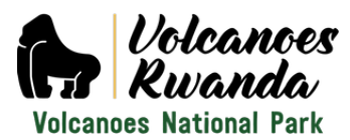Birding in Rwanda never goes without a mention of Volcanoes National Park which is also one of Africa’s best gorilla trekking safari destination. The 160 sq kms safari park lies in the Northern side of the country, about 2-3 hours’ drive from Kigali. There are about 200 bird species living in there and if you are a keen bird watcher, it’s possible to see more than half of that number. There are about 180 bird species that were recorded in this park in the 1980s and then in 2004, about 15 more species were recorded after the biodiversity survey.
Volcanoes National Park occupies a small surface area thus offering birders a great opportunity to spot out about half of its birds. Birding tours in this protected area is amazing because there is possibility for tourists on Rwanda safari to incorporate gorilla trekking, golden monkey tracking, Volcano hiking or nature walks with bird sighting.
Of the 180 species of birds recorded in the Volcanoes National Park, there are 17 of the total 25 Albertine Rift endemics, three globally threatened bird species such as the Kivu ground thrush, Lagden’s bush-shrike as well as the African green broadbill.
Additionally, 13 species and 16 species are native to the Rwenzori Mountains and Virunga Massif respectively while 53 of the 74 species of the Afro-tropical highlands biome that occur in Rwanda call the Volcanoes National Park home.
Other common bird species you are likely to encounter during a birding safari in Volcanoes National Park include Rwenzori Turaco, Archer’s ground robin, strange weavers, handsome francolins, Collared Apalis, Dusky crimson-wing, Yellow-eyed black flycatcher, the Red-faced woodland warbler, Rwenzori double collared sunbird, Rwenzori Batis, the masked mountain Apalis, Grauer’s Rush-warbler, Rwenzori Hill babbler and many others.
There are also birds like Grauer’s rush warbler a vulnerable which is a local bird species commonly seen in the swamps, there are about sixteen different species that are endemic to the Albertine Rift for example the handsome francolin, the Rwenzori Turaco, the Archer’s ground robin, the red-faced woodland warbler , the dusky crimson-wing, Rwenzori double collared sunbird, there is the collared apalis and the Rwenzori batis as well as the strange weaver among so many others.
Unlike other tourist activities within this Park that are mainly conducted within the dry season, Bird watching is different because it is best enjoyed during the rainy season because that’s when you will get higher chances of spotting the migratory bird species.
Birds to expect to identify in Volcanoes National Park
Birding safaris in Volcanoes National Park never leave birders bored! There are varied avifaunal species to keep an eye on all through while in the jungles and these include the Kivu ground thrush, Rwenzori batis, Grauer’s warblers, dusky crimson wing, Rwenzori double collared sunbird, Archer’s ground robin, strange weavers, red faced woodland warblers, collared apalis, Rwenzori Turaco, Lagden’s bush shrike, African green broadbill.
While on bird sighting, there is also possibility for tourists on Rwanda safari in Volcanoes National Park to spot out other wildlife species that the park protects. Other wildlife species the park protects include the bush bucks, the rare mountain gorillas, the playful olive baboons, black and white colobus monkeys, the endangered golden monkeys, giant forest hogs, duikers, buffaloes, forest elephants, bush pigs, red tailed monkeys, spotted hyenas.
Things to carry on birding in Volcanoes National Park?
The Volcanoes National Park is undoubtedly an excellent birding safari destination but what should you pack? There is endless list of items one should carry while on a bird watching tour in Volcanoes National Park or any other outstanding birding spots.
- Carry a birds guidebook, camera, binoculars, enough drinking water and snacks, a back pack for carrying your lunch, drinking water and gadgets, wear a hat and sunglasses, wear long sleeved shirt and long trousers because you will be traversing through the jungles with unpleasant vegetation that can injure your legs and arms, strong waterproof hiking boots, long socks, carry a walking stick, a rain jacket and a sweater due to the unpredictable weather. Don’t forget to hire a porter to help carry the backpack.
- Besides gorilla trekking, birding is also another reason to visit Volcanoes National Park to sight over 180 species of birds including African green broadbill, the Kivu ground thrush and Lagden’s Bush-shrike among others.
- A quick list of things to carry should include a pair of binoculars, good camera with extra batteries and cards, field guide, a valid passport, visa, yellow fever certificate (this should be obtained prior actual date of travel), sunscreen, insect repellents, long pants, flashlight, field bag (should be waterproof), hiking boots (waterproof), rain jacket, anti-malaria pills, toiletries, safari hat, long-sleeved shirts and sunglasses.
When you should visit Volcanoes National Park for birding
Volcanoes National Park is an open bird watching park all year round. This is due to its favorable weather and climatic conditions. The best months to navigate through the rain-forest of this park to identify most of its birds are the dry months of year starting from June, July to August and from December, January, bird watching adventure reduce. There are also migratory birds that are attracted to this park during the wet season which is also the breeding period for most birds making it also an ideal time for bird watching especially November and April.
Besides the bird species, Volcanoes National Park is a home to several mammals including the mountain gorillas, golden monkeys, African elephants, Hippos, Giraffes, Forest Buffaloes, the black-fronted duikers, bush bucks, spotted hyenas and many others. Not only that, five of the eight volcanoes including Mount Karisimbi, Bisoke, Sabinyo, Gahinga and Muhabura of the Virunga Massif are found within the forest park. Therefore other activities can also be enjoyed and these include mountain/volcano climbing, the Dian Fossey grave site hike, visit to the Twin Lakes of Ruhondo and Bulera, cultural encounter, gorilla trekking golden monkey tracking and others.
